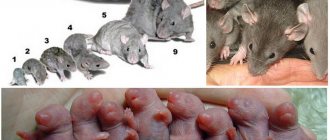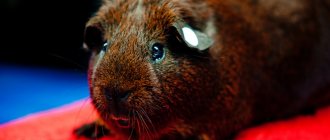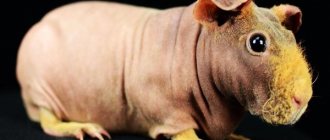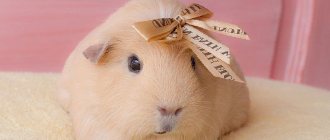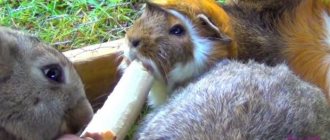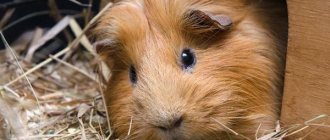Baby guinea pigs are fragile creatures. Even in keeping adult animals there are rules, the violation of which leads to a deterioration in their health and appearance. Newborn animals must be handled with extreme caution. To avoid undesirable consequences, you should carefully study the features of caring for your guinea pig's offspring.
What do newborn guinea pigs look like?
A guinea pig gives birth to 1–5 babies. Their weight ranges from 45–140 grams and depends on the number of individuals in one litter: the more there are, the less the weight of each pet will be. Often, during the first birth, the female produces only one, but large, cub. If the animal is born very small and its weight does not exceed 40 g, the mother will not care for it.
From birth, piglets are endowed with the following characteristics:
- open seeing eyes;
- formed coat (unless these are representatives of hairless breeds);
- developed hearing;
- permanent teeth;
- hard, sharp claws on the paws.
Thus, newborn guinea pigs look like smaller copies of adults. A few hours after birth, they are already able to move briskly. Despite their apparent independence, piglets will not survive without maternal care, so they should not be weaned off early.
During lactation, the female has only two active nipples. If there are many individuals in the litter, they take turns feeding. Milk has a high fat content (45%) and nutritional value, so it is enough for the entire brood.
Signs of pregnancy
The earliest symptom of pregnancy is the absence of another heat cycle. In addition, you can see with the naked eye that the rodent’s belly has increased in size.
At the 3rd week of gestation, the female’s genitals become loose and increase in size.
Due to hormonal changes in a pregnant guinea pig, small cracks often appear on the skin, which need to be lubricated with baby cream without any fragrances.
If you pick up the animal and try to palpate the abdomen, you can feel small lumps. At the 4th week, you can determine how many fruits the female is carrying, since at this stage they can already be clearly felt. The pig does not like such manipulations, and it may begin to break free and bite. As soon as the pet begins to show dissatisfaction, it should be immediately put back in the cage
Particular care should be taken when pressing on the belly of a rodent in late stages of gestation, as this can provoke early termination of pregnancy.
Starting from the 4th week, the animal begins to quickly gain weight. When this is not observed, you should show the rodent to a veterinarian.
At the 6th week, the animal becomes less mobile and sleeps most of the day. Watching a pregnant pig during this period, you can notice how the cubs move.
How long pregnancy lasts in guinea pigs depends on the breed, size of the rodent and the number of fetuses. On average, it lasts 64 days, but when the female carries only 1-2 cubs, she can be pregnant for 75 days, and when there are many fruits, the period is reduced, and childbirth can occur on 58-62 days.
It is better if a pregnant guinea pig is separated from other rodents, because:
- a male can cover a female who has just given birth, and this is undesirable because may cause deterioration in her health;
- other females, alarmed by the birth of their offspring, can harm the newborns;
- other animals may disturb the pregnant female, which can cause premature birth and death of the litter.
Often, during the period of gestation, a rodent exhibits signs of toxicosis, namely:
- the female refuses to eat;
- looks disheveled;
- she has increased salivation and muscle spasms;
- she is indifferent to what is happening, her eyelids are drooping
Toxicosis can be provoked by:
- stressful situations;
- high temperature and humidity of the environment;
- poor diet;
- water shortage;
- multiple pregnancy.
What to do if your guinea pig gives birth
A day after giving birth, you need to briefly remove the female from the cage and inspect the litter. If dead or non-viable cubs are found, they are removed from the cage. In this case, you need to be careful and not touch living and healthy individuals. Before and after the procedure, you must wash your hands with laundry soap. Complete cleaning of the cage is carried out only three days after the birth.
If the male lived in the same cage with the female, after the birth of the offspring he is moved to another place. Living together can provoke re-fertilization, which will ultimately negatively affect the health of the female. This will increase the likelihood of the death of the first offspring. In addition, it is not uncommon for adult males to kill newborns. Therefore, the mother remains alone in the cage with her brood.
There are cases of postpartum shock in the female, when she does not care for the cubs, but tries to move as far away as possible. In this case, she needs to be briefly separated from the offspring and calmed down with affection or special treats. In the absence of the mother, a heating pad is placed in the cage to prevent the pigs from freezing. It usually doesn't take long for the female to calm down.
As a rule, a nursing mother has enough milk for her entire litter. Otherwise, milk or cream is added to her diet. This will help the body replenish its supply of nutrients.
Sometimes the appearance of weak and non-viable cubs occurs. This happens for the following reasons:
- Malposition.
- Large litter - the more individuals in the litter, the smaller and weaker each of them will turn out.
- Early birth, premature animals have poor fur and soft claws.
Weak piglets are characterized by small size and lethargy (cannot roll over or raise their head). Females do not care for such cubs. You can try to feed such animals yourself, but they have little chance of survival.
Puberty
Appears quite early:
- The first heat in females is observed at 8 weeks,
- males mature a little later - usually by three months of age.
But puberty does not mean that rodents can and should mate. At such a young age, the body is not fully formed, and mating will not give the expected results: either fertilization will not occur, or the litter will not be viable.
In addition, early coating seriously undermines the health of the pet, especially females. After unjustified haste throughout her life, she will often get sick, and, consequently, bear weak and underdeveloped offspring. The danger of early mating also lies in the possible death of the animal during childbirth, when the pelvis and birth canal are not yet sufficiently developed.
Experienced breeders recommend using animals at least 10 months old to produce healthy offspring. In some cases, younger six-month-old individuals are also used for these purposes.
It is important to understand that living conditions, diet, and breed play a significant role in the onset of puberty.
Caring for cubs in the absence of a mother
In rare cases, the mother dies during childbirth or due to infection. The most suitable option is to place the newborns with another lactating female. In order for her to accept the piglets, the animals' fur is carefully rubbed with sawdust from their future cage. This way a new scent is applied. Sometimes the fur is treated with camphor oil - this will remove the old smell. After this, the adult pig is temporarily removed from the cage and the foster pigs are placed with her own offspring. With all the precautions, she most likely will not notice the addition, and will take care of the new cubs as if they were her own. No more than 1–2 piglets should be added.
If there is no suitable female nearby, you can feed the animals yourself. To begin with, place a heating pad or other heat source on them. The basis of the diet of newborns is infant formula (formula from birth, from 0 months). Feeding is carried out with a pipette or using a syringe without a needle every 3 hours day and night. After a few days, feeding at night stops. At first, the dose per meal is 0.5 ml. Over time it increases depending on appetite. From 4–5 days, children's vegetable purees or children's dairy-free porridge are given a couple of times a day. Feeding with milk or dairy products is not recommended.
As usual food, they give rolled oats flakes, hay and vegetables in small quantities. The cubs feed on formula for 21–28 days. You can monitor the development of pigs by weighing them daily.
Newborn pigs also need help with bowel movements. To do this, take a piece of cotton wool moistened with vegetable oil or boiled water and massage the abdomen and genitals. Under normal circumstances, this is done by the mother.
Pregnancy period
Length of pregnancy
Average time is about 10 weeks. The duration of this period can be affected by the animal’s age, breed, number of fetuses, as well as the health characteristics of a particular female. Of course, if there are two or more babies in the tummy, then the gestation period will be reduced to 58-62 days. When the baby is the only one – 70-75 days.
Number of cubs
If a guinea pig becomes a mother for the first time, it often means 1, maximum 2 babies. In case of repeated pregnancy, the probable number of children is 2-5.
Unlike hamsters, guinea pigs are born with their eyes open and fur. Which makes them somewhat independent from their mother.
Caring for your pig during pregnancy
The owner’s task is to create a comfortable, calm environment for the expectant mother, so that the pregnancy proceeds well and the birth occurs on time. Loud sounds and noise should be avoided, and you should also avoid picking up the pig often.
There is a set of simple but important recommendations:
- As soon as it becomes clear that the guinea pig is pregnant, you need to transplant it from the male and other neighbors into a separate cage. This is necessary for a calm environment, and to avoid re-mating immediately after childbirth.
- Leave only the essentials in the cage - a drinking bowl, a bowl of food, a house. Remove ladders, swings, etc., eliminating the risk of injury.
- The cage should be located in a place where there are no drafts, no sudden changes in temperature, no direct sunlight, as this can cause toxicosis in the animal, even death.
- Bathing should be avoided during pregnancy, so as not to further frighten the animal.
- Do not pull the female out of the cage unless necessary, but if necessary, this should be done carefully, with both hands, supporting the tummy.
- Skin care may be required as cracks may appear on the abdomen. It is enough to lubricate with baby cream. If the breed is long-haired, then at the beginning of pregnancy you should cut the hair so that it does not get dirty.
- It is recommended to replace the hay bedding with fresh hay daily and wash bowls and drinking bowls. The cleaning process should take place calmly, again, so as not to scare the animal.
- If the pet is not shy and shows interest, then short walks outside the cage are allowed to maintain activity and prevent possible obesity.
- You should only visit a veterinarian if there are any disturbances in behavior or well-being.
Diet of a pregnant animal
It is very important not only to increase the diet depending on the period, but also to make it complete and balanced. It is during pregnancy that pigs lack vitamin C and calcium, which are very important for future offspring.
Monitor the availability of clean water in the drinking bowl.
In addition to the usual food, hay, fresh vegetables, herbs and fruits, the guinea pig's menu should include:
- Dairy products (cottage cheese, milk);
- Specialized food for pregnant pigs.
Refusal to eat after delivery is a signal that you urgently need to visit a veterinary clinic. The cause may be serious health problems.
Development of newborn guinea pigs by day
Pig cubs are born sighted, hearing and covered with hair. Their further development consists of increasing body size and strengthening the body.
Piglets grow very quickly. For the first time, weight increases on the second day - by 1 gram. Starting from the third day, the increase is 3–4 grams per day. Two weeks later, the animals weigh twice as much as at birth. Rapid growth continues until 7–8 weeks, after which it slows down. Normal weight at this age is about 0.4 kg.
Full formation of the body lasts up to 15 months. An individual is considered an adult from 6 months, when the male reaches 900–1200 g, and the female 500–700 g.
When can you pick up babies?
During the first week, newborn pigs should not be touched so as not to leave a foreign smell on them. Sensing it, the female may abandon the piglets or even kill them. In addition, the cubs are extremely fragile and careless movement can harm them. If touching is unavoidable, you should wash your hands with laundry soap before doing so.
After a week, you can easily touch the pigs, stroke them, give them treats so that they get used to the unfamiliar smell and are not afraid of it. Over time, the owner's scent will create positive associations for them, and they will no longer be afraid. You can pick up the cubs in your arms and take them out of the cage from the second week.
The animal should be moved with extreme caution, picked up under the belly and under no circumstances lifted by the back. The bones and entrails of small pigs are very fragile. Games and other manipulations are carried out calmly and carefully, without loud sounds or sudden movements. If the animal is trembling or squeaking, it is better to postpone the procedure of close acquaintance until next time.
When can you give away guinea pigs after birth?
Guinea pig cubs can be separated from the 4th week, when they have already finished feeding on milk. But until 5–6 weeks, milk or cream is manually added to their diet. Too early weaning from mother's milk threatens pigs with disturbances in growth and development. And vice versa - a long stay with the offspring negatively affects the female herself. Prolonged breastfeeding undermines her health. For this reason, the most well-fed cubs are placed first.
At the age of one month, males have already reached puberty and until this moment must be separated from their mother and other females. From this age, pigs can be distributed to new owners.
Caring for newborn guinea pigs
The female independently provides proper care for the offspring and does not need additional help. The owner’s task is to provide care for the mother: to create favorable conditions in the cage and in the room where she is located.
The cage for a female with a brood is chosen to be spacious, with a minimum distance between the bars. If before the birth there were hammocks, ladders, or additional shelves, they are removed afterward to minimize the risk of injury. Feeders and drinking bowls are provided in sufficient quantities for all animals. Every day (starting from the fourth) the cage is wet cleaned and the filler is replaced. Once a week it is disinfected along with the feeders.
The atmosphere in the room with the cage should be quiet and calm. Cubs react to noises especially painfully. Standard room temperature is suitable, but not lower than 18 degrees. The female often licks the piglets, and a low temperature will lead to a cold. The cage is placed as far as possible from drafts and direct sunlight.
Selection of animals for breeding
It matters a lot. Pigs must be:
- well-fed,
- agile and cheerful,
- absolutely healthy,
- have excellent breed qualities,
- with wool of excellent quality and characteristic color.
A female should not be bred more than twice a year, since frequent “work” undermines her health and, as a result, her offspring will be weak and of poor quality. Uncontrolled use of males will also lead to unpleasant consequences - the potential mother will remain unfertilized.
A week before and during mating, animals are given food rich in vitamin E - sprouted wheat, barley, oats, as well as succulent food. The best time for reproduction is considered to be spring and summer, when there is a lot of varied food.
Obese, overly dense or thin, sick animals should not be allowed to crossbreed.
What to feed a baby guinea pig
Cubs feed on mother's milk until 3–4 weeks. However, from the very first days, a bowl of regular food is placed in the cage (not counting the feeder for the female) so that they get used to normal food. Their diet includes cereal flakes, mixed feed, and nuts. It is important to monitor the freshness of products. Leftover food is thrown away every time so that it is not eaten in a weathered or spoiled state.
Along with food and water, the pigs are provided with high-quality, dry hay. It will help grind teeth and cleanse the intestines. Vegetables and fruits are occasionally added as treats: cabbage, lettuce, apple, carrot. Sometimes the cubs eat a small amount of their mother's droppings, which contain vitamins B and K, which are beneficial to the body.
Guinea pigs breed almost entirely offline. The female independently gives birth to cubs, feeds and cares for them. The owner is only required to provide them with a calm environment, cleanliness and sufficient food and water.
Mating
For one male there should be from 5 to 10 female pigs. Some breeders keep them together, others separately - there is no fundamental difference. In the case of separate keeping, the female during estrus is placed in a cage with a “man”.
The hunt lasts about two days, the frequency of estrus is 13-20 days. The favorable period for fertilization lasts about 10 hours. The female takes a characteristic pose (she is motionless, her hind legs are apart, her croup is raised) and is ready to let her partner approach her.
